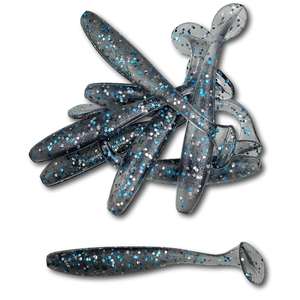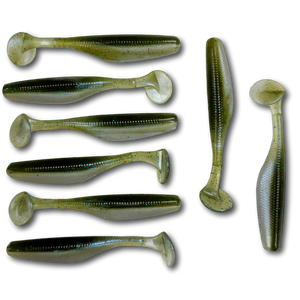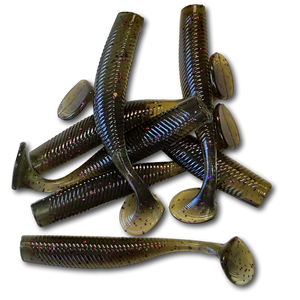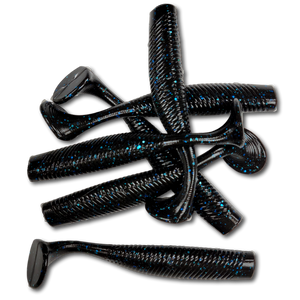Swimbaits
Swimbaits are soft plastic lures with a paddle tail that creates a natural swimming motion as they move through the water. These baits mimic a wide range of forage species, including shad, minnows, bluegill, and even larger prey like herring or small trout.
The versatility of swimbaits makes them effective in almost any situation, from shallow flats to deep reservoirs. They’re designed to trigger reaction strikes from predatory fish by replicating the look and movement of their natural prey.
Swimbaits can be rigged in various ways to match different fishing conditions and target species. Here are the most popular presentations:
Swimbait Jig Head: Rigging a swimbait on a jig head is one of the simplest and most effective setups. This allows you to fish the bait at any depth, whether you’re casting and retrieving in shallow water or slow-rolling it along the bottom in deeper areas.
Underspin Rig: Adding a small spinner blade beneath the jig head creates flash and vibration, making your swimbait more visible in stained water or low-light conditions. This setup is perfect for imitating baitfish schools.
Texas Rig: Rigging a swimbait Texas style keeps it weedless, allowing you to fish through vegetation or heavy cover. This is particularly effective when targeting bass in grassy lakes or river systems.
Carolina Rig: For deeper water, a Carolina rig keeps your swimbait near the bottom while allowing it to move naturally with the current. This is ideal for targeting walleye, bass, or other fish holding on ledges and humps.
A-Rig (Alabama Rig): Swimbaits excel as part of an A-rig, which mimics a school of baitfish. This setup is highly effective for bass and striped bass in open water or around structure.
Weightless Swimbait Hook: A weightless rig allows your swimbait to glide naturally just below the surface. This presentation is ideal for targeting fish in shallow water or over submerged vegetation.
Swim Jig Trailer: Adding a swimbait as a trailer to a swim jig gives your presentation extra bulk and action, making it even more appealing to larger fish.
Swimbaits are effective year-round, but they truly excel when fish are actively feeding on baitfish or other prey:
- Spring: Swimbaits are perfect for pre-spawn and spawning fish. Cast them near shallow flats, spawning beds, or transition zones where bass are moving in and out of cover.
- Summer: As fish move deeper to avoid the heat, swimbaits fished on jig heads or Carolina rigs can target bass or walleye holding on ledges, drop-offs, and brush piles.
- Fall: This is prime time for swimbaits as fish chase baitfish into shallow water. Cast swimbaits along riprap, grass lines, or shallow flats to capitalize on aggressive feeding behavior.
- Winter: In cold water, swimbaits fished slowly along the bottom can tempt lethargic fish. Use smaller swimbaits or downsize your rig to match the fish’s reduced energy levels.
Swimbaits excel in lakes, reservoirs, and rivers, especially in areas with abundant baitfish populations. They’re also effective in saltwater environments, where they can mimic mullet, sardines, or anchovies.
Best Colors and Sizes for Swimbaits
Choosing the right color and size for your swimbait depends on the conditions and target species:
- In clear water, natural colors like silver, white, and shad patterns are the most effective.
- In stained or murky water, brighter or high-contrast colors like chartreuse, firetiger, or black and blue help fish locate your bait.
- For low-light conditions or night fishing, darker colors like black or purple create a strong silhouette.
Swimbaits range in size from 2 inches to over 8 inches. Smaller swimbaits (2-4 inches) are ideal for finesse presentations or targeting smaller fish like crappie or spotted bass. Larger swimbaits (5-8 inches) are perfect for big bass, walleye, or even saltwater species like redfish or striped bass.
Why Swimbaits Are So Effective
Swimbaits excel because they closely replicate the look and movement of natural forage. The paddle tail creates a realistic swimming motion, while the soft plastic material gives the bait a lifelike feel that encourages fish to hold on longer.
Their versatility allows anglers to target fish at any depth and in almost any condition. Whether you’re fishing clear water, stained water, shallow flats, or deep ledges, swimbaits can adapt to the situation and deliver consistent results.
Tips for Fishing Swimbaits
When fishing swimbaits, match your retrieve speed to the fish’s behavior. A slow, steady retrieve often works best, but speeding up the retrieve or adding occasional pauses can trigger reaction strikes.
Use fluorocarbon or braided line with a fluorocarbon leader to maximize sensitivity and maintain a natural presentation. For larger swimbaits, consider heavier tackle to handle the weight of the bait and the potential for big fish.
Pay attention to your bait’s action and adjust your rigging as needed. If the swimbait isn’t swimming naturally, check the alignment of the hook or try a different jig head size.
Soft plastic swimbaits are a must-have for any angler targeting predatory fish. Their realistic action, versatility, and ability to mimic natural forage make them one of the most effective lures in your arsenal. Whether you’re fishing shallow water, deep structure, or open expanses, swimbaits can help you land the fish of a lifetime. Stock up on your favorite sizes and colors, and let these lifelike baits take your fishing game to the next level.
Qwik Catches!











